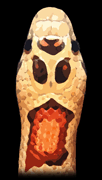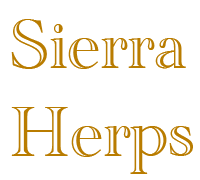
Nuevo Leon Kingsnake — Lampropeltis leonis Günther 1893 (formerly L. mexicana thayeri)
Other Common Names: Variable Kingsnake, Thayeri
Spanish Names: Falsa Coralillo, Culebra Real de Thayer
Original Description: Günther, A. C. 1893. Biologia Centrali-Americana: Reptilia and Batrachia. 1885–1902: xx + 326 pp. [description presented on p. 110]. See also “Comments” section below.
Holotype & Type Locality: BMNH 89.7.3.41 (re-registered as 1946.1.4.10), an adult female, collected by W. Taylor, from “Nuevo Leon, Mexico.”
Etymology: The species name references the state of Nuevo Leon, collecting locality of the type specimen.
Scientific Describer: Albert Carl Ludwig Gotthilf Günther (1830–1914) was a German-born ichthyologist and herpetologist who spent his scientific career at the British Museum of Natural History. As was common for the era, Günther pursued a career in zoology upon completion of his medical degree. A summary of his herpetological contributions is included in Adler (1989, pp. 45–46). A wonderfully revealing biography by his grandson, A. E. Gunther, was published with the reprinted edition of “Biologia” by SSAR in 1987. As noted by Adler in his preface to the reprint, “Günther’s volume on amphibians and reptiles is one of the most important publications on the herpetology of Middle America and is still in active use.”
Distribution: Northern segments of the Sierra Madre Oriental, mostly in the states of Nuevo Leon and Tamaulipas, but also in extreme eastern Coahuila and northern San Luis Potosí. Specimens have been recorded from both the western and eastern flanks of the Sierra Madre.
Habitat: The western segment of the range coincides with the interface of the Chihuahuan Desert and the Sierra Madre Oriental. Snakes have been found in diverse settings, ranging from localities with the look and feel of Chihuahuan Desert scrub (e.g., Doctor Arroyo, NL) to more more mesic sites (e.g., Aramberri, San Juanito, Galeana). There are reports of snakes having been found within the oak-pine zone along the road between Doctor Arroyo and Galeana. On the eastern escarpment of the Sierra Madre Oriental, summer storm tracks moving out of the Gulf of Mexico bring higher rainfall and increased humidity, resulting in a lush environment with a decidedly tropical look and feel. The San Roberto Highway (Mex. 31) that runs east–west from Linares to San Roberto vividly illustrates this. In the eastern segment of this road, tricolor-morph L. leonis have been taken on roads at night, and occur sympatrically with Micrurus tener (Texas Coralsnake).
Growth and Size: Typical of other members of this complex, although smaller than alterna. Adults are generally 24–36 in. (61–76 cm) TL, with hatchlings starting out at 8–10 in./20–25 cm TL. Captive raised snakes can reach sexual maturity at less than 24 months if “power-fed,” but 32 months is more typical.
Pattern Variation: Where to start? One would be challenged to find a species of snake anywhere that displays such a remarkable array of color and pattern combinations as L. leonis. To be sure, there are species that exhibit pronounced patterns of geographic variation, but in leonis much of the variation can emerge among clutch-mates. Our photo gallery depicts much of the incredible variety of leonis.
Typically, individual L. leonis are categorized as “leonis” morphs (characterized by relatively narrow red/orange bands with black borders) or tricolor morphs, commonly referred to as “milksnake” phase (looking, as the name suggests, like a tri-colored Lampropeltis triangulum). As a tour of our Gallery reveals, there is great variation within those two general pattern types, especially among leonis-morph animals. In these, ground color can range from almost white, to gray, brown, orange, rose, tan, pale green, dark green, and shades in between. In some of the brown-tan (“buckskin”) forms, there is an orange suffusion that develops in the posterior part of the body and increases anteriorly, becoming more pronounced during the transition from hatchling to adult. Variation among tricolor snakes includes number (and thus width) of the red-orange bands, the color of the light rings (white, gray, yellow, or orange), and head ornamentation. Some snakes display patterns that are not quite leonis-phase and not quite milksnake/tricolor phase; these “intermediate” morphs are much less often seen and can be exceptionally attractive.
In addition to the standard forms, a melanistic phase occurs. These snakes are usually solid black or black-brown, invariably iridescent and quite striking. If held in the right light, it is possible to glimpse traces of the underlying leonis or tricolor pattern. The melanistic morph results from a homozygous recessive condition.
Through many generations of line selection, breeders have refined the look, the result being cleaner, brighter patterns—in many instances these line bred snakes do not look much like their wild counterparts.
Does such variety occur in the wild? This is not entirely clear. Leonis-phase, tricolor, and melanistic snakes have all been found in the field, and melanistic forms seem to occur throughout the range of the species. Tricolors seem to predominate on the more mesic, eastern flank of the Sierra Madre, where the vegetation takes on a subtropical aspect. We are not aware of any tricolor forms having been found on the more xeric western flank of the Sierra Madre. One piece of data is notable. Of approximately 75 hatchlings produced in captivity by three wild-collected leonis-morph snakes, all from the same area in Nuevo Leon, only 4–5 were tricolor morphs, with the large majority being variations of leonis-morph snakes.
Trying to make biological sense of the remarkable diversity of colors and patterns in L. leonis can be an exercise in frustration. Conventional wisdom is that color and pattern (the phenotype) of snakes reflect selection pressures to avoid detection and capture by visually-oriented predators. Most often, this results in species of snakes that closely match backgrounds—green snakes are common in tropical environments, brownish snakes prevalent in arid regions, and so forth. Sometimes this results in an impressive convergence of color, pattern, and substrate—as in the Banded Rock Rattlesnakes (Crotalus lepidus klauberi) of the southwestern U.S., where lichen-covered rocks are closely approximated in the color and pattern elements of the snakes.
It is tempting to think of the color patterns of L. leonis as potentially mimicking dangerous models: the leonis-morph occurs in or near the range of the Tamaulipan Rock Rattlesnake (Crotalus lepidus morulus), while the tricolor form occurs in or near the range of the Texas Coralsnake (Micrurus tener). Garstka (1982) suggested a mimicry-based system as a way of understanding pattern in alterna, greeri, mexicana, and leonis. However, at present we lack sufficient samples of snakes from throughout the range to offer much beyond speculation. Many of the leonis-phase snakes have muted patterns that appear exceedingly cryptic, especially in the low light conditions typical of surface activity periods. The case for coralsnake mimicry by the tricolor morph is more compelling, and follows a trend seen in numerous forms of Lampropeltis.
Relationships: Scientific understanding of this taxon remains elusive. There seems to be a clear distinction between this form and L. mexicana to the south—where their ranges approach but apparently do not meet and there is no evidence of hybridization. At the northern end of the Sierra Madre Oriental, in the region between Saltillo and Monterrey, the ranges of L. alterna and L. leonis come very close—occupying the mountain areas on different sides of the city of Monterrey. Morphological evidence of hybridization in this northern area is ambiguous and could also be interpreted as expressions of the genetic variability inherent in both species. Specimens from this region are rarely encountered, and careful genetic studies are needed to accurately assess the level of interaction—current or historical—between these two lineages. However, at present there is no genetic evidence for contact between these two species. It seems more likely that pattern similarity is the result of natural selection for concealing coloration in similar xeric environments.
Conservation Status: Based on our travels in northeastern Mexico, the overall range of L. leonis has been only moderately affected by habitat modification. However, in some areas, the impact has been more severe, resulting in local extirpations. For example, the areas around Galeana and Monterrey are heavily impacted by human activities. In the case of Monterrey, a region where the ranges of L. leonis and L. alterna closely approach, loss of habitat has been especially severe and in many cases has rendered large areas uninhabitable for snakes.
Captive Stock: Nearly all material available in collections cannot be associated with a discrete geographic locality. Legal exports of live snakes from Mexico were halted in the 1980’s. There are a few captive lines that are locality based, including one from the Aramberri region of Nuevo Leon, and a second from the Chorro Canyon area of Coahuila. Because these kingsnakes readily interbreed with other species of Lampropeltis, several breeders made extensive crosses, involving species such as alterna, pyromelana, ruthveni, mexicana, and zonata. Unfortunately, the progeny of these crosses live on in private collections, and in some cases the owners are unaware of just what they have, as the hybrid origins can be difficult to spot. Many of the specimens sold as “thayeri” are in fact hybrids.
For those with an interest in maintaining the integrity of natural gene pools and who want some assurance that the animals they purchase are as represented, the good news is that there are a few serious breeders who work hard to keep their captive lines “pure.” Our collection falls into this category, and represents the full diversity of pattern and color variation that makes L. leonis such a remarkable snake.
Comments: Following the description of L. leonis in 1893, this name received little attention. In 1924, Arthur Loveridge described L. thayeri from Miquihuana, Tamaulipas (based on Museum of Comparative Zoology 19551, an adult male, collected by Wilmot W. Brown on 16 June 1924). The name thayeri is a patronym honoring Col. John Eliot Thayer of Boston, Massachusetts, who presented to the MCZ a small collection of reptiles from Miquihuana, including the kingsnake described by Loveridge.
Loveridge (1924) also reported on four new specimens received at the MCZ (19022–25) that were collected from Alvarez, San Luis Potosí [located immediately adjacent to the Valle de los Fantasmas]. Curiously, he assigned this new material to L. leonis (until then, known only from the type specimen, residing in the British Museum), clearly not realizing these were examples of L. mexicana (the type locality of which was only a short distance to the west). Thus, the taxonomic waters were muddied early on. Later workers (Smith, Webb, Gehlbach, Blaney, Garstka) also seemingly did not recognize the alliance of leonis and thayeri, and by extension, the primacy of the name leonis. As recently as 2008, the name thayeri (as L. m. thayeri) continued to be used to the exclusion of leonis (Liner and Casas-Andreu 2008). Because L. leonis is the earliest available name and was accompanied by a valid description (including a well-executed figure), it has priority and thus is the appropriate appellation for the Mexicana-group snakes of the northern Sierra Madre Oriental.
